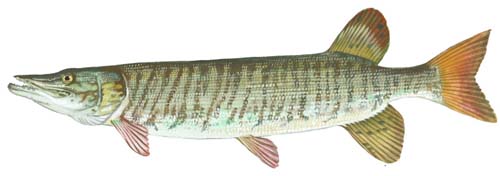The tiger muskellunge is a hybrid species of northern pike and Muskellunge and is quite rare. Anglers consider the fish one of the most prized freshwater catches. Tiger muskies can be caught using live bait or artificial lures. Jerkbaits, crankbaits, and spinnerbaits are ideal for catching tiger muskellunge.

Region: Northeast, West, SouthHabitat: Lake, Pond, River
How to identify Tiger Muskellunge
The tiger muskellunge is a hybrid subspecies of pike created when a male northern pike breeds with a female muskellunge. Tiger muskellunge are sterile, they cannot reproduce on their own. Eggs laid by female muskellunge are fertilized by male northern pikes, and a tiger muskellunge is produced.
The tiger muskellunge is not the same species as the muskellunge. Tigers are often referred to as “tiger muskies,” and because of their rarity and uniqueness, anglers consider this fish a prize catch.

The markings along its flanks are what sets the tiger muskie apart from muskellunge and northern pike. Tiger muskies have olive-colored vivid wavy “tiger” like stripes on their sides, whereas muskellunge have bars/spots along their flank, or nothing at all. The color scheme of the tiger muskie is opposite that of a northern pike. The tail fin of the tiger muskie is also rounder than that of a muskie.
Where to catch Tiger Muskellunge
Tiger muskies are found in calm rivers throughout Canada, and many of the states bordering Canada. They are naturally found in the Great Lakes area, Ohio River, St. Lawrence Rivers, as well as the Upper Mississippi Valley. Natural reproducing populations of tiger muskies are rare. Stocked populations of tiger muskies are found in Michigan, Minnesota, Wisconsin, Montana, Utah, Idaho, New Mexico, Wyoming and the upper New England area (New York, Massachusetts and New Hampshire primarily).
Range: Northeast, Midwest
A tiger muskie tends to stay put once they find a spot they like. tiger muskies will inhabit the same areas from year to year. During the warmer summer months you’ll find tiger muskies in 6-9 feet of water. As winter approahes, they’ll move to depth of 15-30 feet until the water temperatures warm come spring.
Tiger muskies are usually found in bays, inlets, lakes and calm flowing rivers. They prefer weed beds where they can ambush unexpecting prey. Between May and September tiger muskies are often found near the top of weed beds just out of sight.
As apex predators, tiger muskie are territorial. They will often drive other muskies from their territory. There may be no more than one or two tiger muskie inhabiting the same area. To find a tiger muskie, and get a bite, you’ll need to make a lot of casts.
The following are habitats where you can catch tiger muskellunge:
- Cliffs and Steep Shore Banks
- Freshwater Lakes and Ponds
- Freshwater Weed Beds
- Gradual Shores
- Lake and Pond Fishing Holes
- Points and Break Lines
- Riparian Zones
- Rivers and Streams
- Rocks
- Sunken Objects
How to catch Tiger Muskellunge
The tiger muskellunge is considered a prize catch by anglers due to its rarity. If you do manage to hook one, they will put up quite a fight. Seasoned muskie anglers recommend using a rod that is light enough that you won’t tire and can feel the bite, but strong enough to reel in a 70-pound monster.
A good all-around tiger muskie setup is a 7′-8′ fast-action, medium to heavy rod, 3/4-3ox lure, and 20-30 pound test monofilament or braided line. And don’t forget its sharp teeth. You’ll also need a wire or strong flourocarbon leader.
The following are few additional rod recommendations for tiger muskie.
Rod TypeLure TypeRecommendation7′-9′ inches HeavyJerkbaits, Topwater Baits, Glide BaitsStrong7’6 inch Medium-HeavySpinnerbaits, Bucktails, Spoons, Small-Medium CrankbaitsStrong7′-7’2 inch Medium-HeavyLarge Crankbaits, Swimbaits, Topwater LuresMedium
The following are traditional fishing methods for catching Tiger Muskellunge:
- Bait Casting
- Drift Fishing
- Spinning
- Still Fishing
- Trolling
A popular technique for increasing your catch rate is the “muskie figure eight.” This technique involves dragging your bait or lure in a figure eight pattern as it approaches the boat. This maximizes the opportunity for a stalking tiger muskie to get in a last bite.
Best Lures, Bait & Tackle to catch Tiger Muskellunge
Live bait or artificial lures can be used for catching Muskellunge. If using live bait, it’s important to use large baitfish. Make sure your rigging is perfect to ensure bait fish remain alive.
Tiger muskies will readily take artificial lures. The most effective lures for getting tiger muskie to bite are crankbaits, jerkbaits, spinnerbaits, bucktails, plugs, and topwater baits. The best tiger muskie lures are flashy and produce noise.
The following are fishing lures, bait and tackle that can be used to catch Tiger Muskellunge:
- Crankbaits
- Spinnerbaits
- Minnows
- Plugs
- Spoons











































